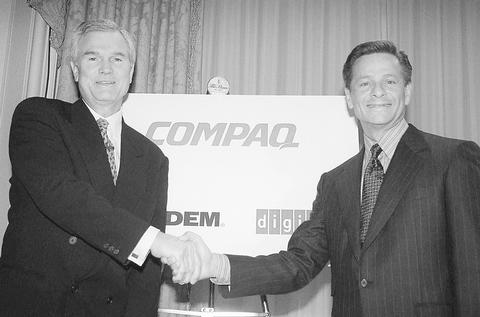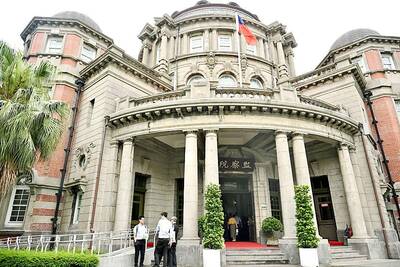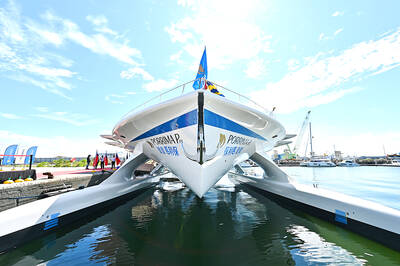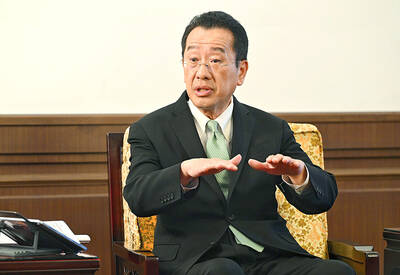The US$19.5 billion marriage of Hewlett-Packard Co and Compaq Computer Corp appears to have survived a corporate civil war. Now it has to overcome the simple fact that, more often than not, high-tech mega-mergers fail.
Despite their architects' high hopes and detailed plans, such mergers often create confusion over dueling cultures and product lines, leading to defections by employees and customers.

PHOTO: AP
"Hardware mergers have just been disaster after disaster," said James Schrager, a professor at the University of Chicago's Graduate School of Business. "You can go way back and walk through the rubble."
There was AT&T Corp's union with NCR Corp in 1991. It lost billions before NCR was spun off in 1996. Or Silicon Graphics Inc's acquisition of Cray Research the same year. SGI is still trying to regain its lost glory.
Then there was the merger of Sperry Corp and Burroughs Corp in 1986 to form Unisys Corp, which was to have challenged IBM in the mainframe market. IBM never lost its lead.
And nobody at Compaq will forget its acquisition of Digital Equipment Corp in 1998. Promised benefits simply never appeared.
HP and Compaq will have to resolve culture clashes, mesh product lines and soothe customers amid the not-so-cheery atmosphere of the planned 15,000 layoffs at the combined company.
After shareholder approval is certified, the new HP will have to prove it's greater than the sum of its parts, and that two behemoths can innovate just as nimbly as smaller competitors and startups. Innovation is a function of employee energy and leadership.
"Buying another weak player usually hurts innovation," Schrager said. "A great deal of the top-level corporate resources are all oriented toward making the merger happen instead of keeping innovation flying."
Mergers are rarely easy in any industry. High-tech companies, however, must launch new products quickly and rely more on employees -- assets who can easily walk out the door.
"When you buy brains, the asset is highly volatile. It's got to be nurtured, cared for, suckled," said Paul Hammer, a senior vice president at Houlihan Lokey Howard and Zukin Investment Banking. "If not, it's not going to produce what you want."
Some high-tech mergers do work, but generally only when a big company swallows a smaller firm. Router maker Cisco Systems Inc and software giant Microsoft Corp have successfully acquired important technologies this way.
HP chief executive Carly Fiorina and Compaq's Michael Capellas say their companies are better prepared for the union than any in history. They have been planning integration issues since last summer, and more than 900 employees are working full time on meshing the companies and studying past merger mistakes.
"We are prepared to hit the ground running," Fiorina said. "We have already made the tough decisions."
Of course, no chief executive planning a merger has ever predicted disaster.
In 1998, for instance, Compaq acquired Digital for US$8.55 billion. The goal was to push Compaq into the league of giant IBM.
Compaq's and Digital's cultures clashed. Plans to create a consulting business never took off. Product decisions were not made quickly or changed. Confused customers took their business elsewhere.
"It literally took years for them to sort out the true integration of the two businesses," said David Yoffie, a business professor at Harvard University. "Most of Digital's business has been destroyed."
Walter Hewlett, the son of HP co-founder William Hewlett, often cited grim statistics during his opposition to the Compaq deal: Compaq's value has plummeted 52 percent since Jan. 26, 1998, and earnings dropped from US$1.27 per share in 1997 to an estimated US$0.27 this year.
HP also had problems with its 1989 acquisition of Apollo Computer Inc. Though it at first made gains in the workstation market, those leads quickly vanished amid infighting and confusion.
Some analysts say those failures could hold lessons for the new HP.
"They know 800 things of the 10,000 that can go wrong," said Paul McGuckin, an analyst with Gartner Inc. "There's a reasonable chance they won't make those same mistakes."
HP and Compaq believe that by taking the best of each other's businesses, they will generate better end-to-end technology packages and create a high-tech services behemoth to rival IBM.
HP expects earnings to be 13 percent better next year with Compaq than they would be without it. But repackaging existing products won't be enough -- HP and Compaq will have to develop new inventions customers want to buy.
HP's last world-changing invention, in the opinion of analysts, was thermal inkjet printing -- developed in 1979 and mass produced in 1984. Earlier, it had introduced pocket calculators and light-emitting diodes.
Now, printing and imaging -- particularly expensive ink refills -- create the bulk of the company's profits. "It's a statement of how weak the basic HP business has become," Schrager said.
That's not to say innovation has ceased. With Intel Corp, HP jointly developed the Itanium processor for high-end servers. HP Labs is widely considered a leader in ultra-tiny nanotechnology research.
But innovation in basic research is pointless for a company's bottom line unless it leads to marketable products.
Xerox Corp has faced the same problem for years, with its corporate lab inventing the graphical user interface, the laser printer and Ethernet, while other companies reaped the profits.
"If you don't make it into something commercial eventually, it's of very little use and actually an embarrassment after a while," Schrager said. "You've got to do something with it."

GAINING STEAM: The scheme initially failed to gather much attention, with only 188 cards issued in its first year, but gained popularity amid the COVID-19 pandemic Applications for the Employment Gold Card have increased in the past few years, with the card having been issued to a total of 13,191 people from 101 countries since its introduction in 2018, the National Development Council (NDC) said yesterday. Those who have received the card have included celebrities, such as former NBA star Dwight Howard and Australian-South Korean cheerleader Dahye Lee, the NDC said. The four-in-one Employment Gold Card combines a work permit, resident visa, Alien Resident Certificate (ARC) and re-entry permit. It was first introduced in February 2018 through the Act Governing Recruitment and Employment of Foreign Professionals (外國專業人才延攬及雇用法),

WARNING: From Jan. 1 last year to the end of last month, 89 Taiwanese have gone missing or been detained in China, the MAC said, urging people to carefully consider travel to China Lax enforcement had made virtually moot regulations banning civil servants from making unauthorized visits to China, the Control Yuan said yesterday. Several agencies allowed personnel to travel to China after they submitted explanations for the trip written using artificial intelligence or provided no reason at all, the Control Yuan said in a statement, following an investigation headed by Control Yuan member Lin Wen-cheng (林文程). The probe identified 318 civil servants who traveled to China without permission in the past 10 years, but the true number could be close to 1,000, the Control Yuan said. The public employees investigated were not engaged in national

The zero emissions ship Porrima P111 was launched yesterday in Kaohsiung, showcasing the nation’s advancement in green technology, city Mayor Chen Chi-mai (陳其邁) said. The nation last year acquired the Swiss-owned vessel, formerly known as Turanor PlanetSolar, in a bid to boost Taiwan’s technology sector, as well as ecotourism in Palau, Chen said at the ship’s launch ceremony at Singda Harbor. Palauan President Surangel Whipps Jr and Minister of Foreign Affairs Lin Chia-lung (林佳龍) also attended the event. The original vessel was the first solar-powered ship to circumnavigate the globe in a voyage from 2010 to 2012. Taiwan-based Porrima Inc (保利馬) installed upgrades with

ENHANCE DETERRENCE: Taiwan has to display ‘fierce resolve’ to defend itself for China to understand that the costs of war outweigh potential gains, Koo said Taiwan’s armed forces must reach a high level of combat readiness by 2027 to effectively deter a potential Chinese invasion, Minister of National Defense Wellington Koo (顧立雄) said in an interview with the Chinese-language Liberty Times (sister newspaper of the Taipei Times) published yesterday. His comments came three days after US Secretary of State Marco Rubio told the US Senate that deterring a Chinese attack on Taiwan requires making a conflict “cost more than what it’s worth.” Rubio made the remarks in response to a question about US policy on Taiwan’s defense from Republican Senator John Cornyn, who said that Chinese